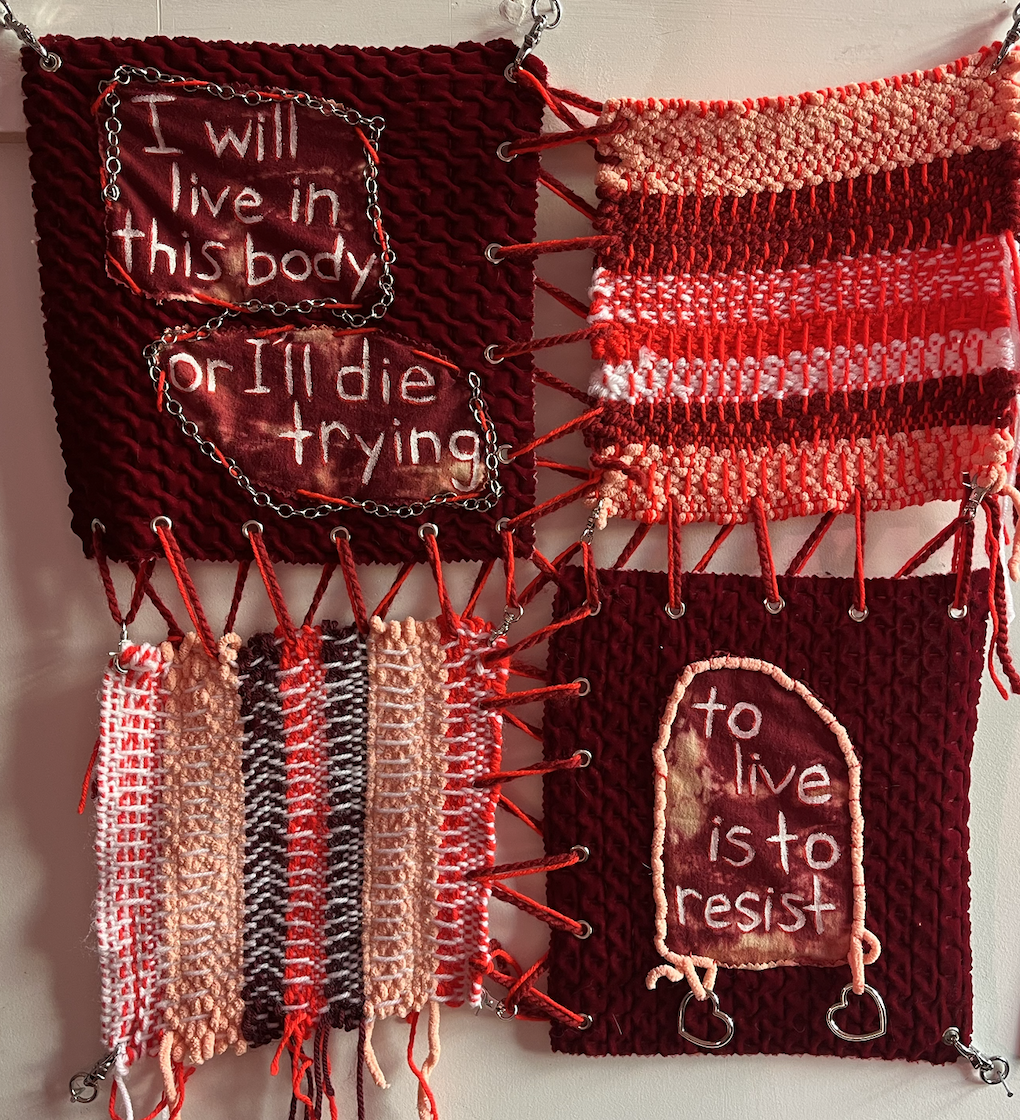Undue Burden
Painted Bride Gallery
5212 Market St
Philadelphia
Nov. 19, 2024
Entering the gallery space at Painted Bride on Market and 52nd, the only other person in the room lets me know from behind their desk that this is a haptic gallery. You can clean your hands with Purell and feel free to touch any of the works in the show.
I feel elated. I’ve never been to a so-called “haptic” show, but was introduced to the term through my journey into Disability Studies. The word “haptic” is derived from the Greek haptikos, which translates to “able to touch or grasp.” For anyone with a Disability that affects one or more of their five senses, the ability to touch visual artwork can be a key means of gripping the creator’s sense of style, intent and meaning.
The name of the exhibit I am seeing inside Painted Bride is “Undue Burden.” The show, curated by Hook&Loop, a Philly-based, accessible art collective led by Disabled adults, consists of multimedia works made by artists from a plethora of backgrounds and Disabled experiences.
After cleaning my hands, I steer my wheelchair between two large fabric pieces hanging in perfect rectangles. Between the tapestries is a papier-mache piece titled “HELP/d.” This is a sculpture by Em Rea, consisting of wires wrapped in papier-mache in the shape of a three-foot spider web hanging in front of a window. Some of the paper hanging between the wires looks ashy and ragged, as though it was burned in a controlled fire. Other pieces of paper appear gauzy in the sunshine.
It is the first piece that I desperately want to touch, but I feel it might disintegrate in my hands. Sitting in front of the window, I am reminded that my vision is only partial, as floaters and dark sections fill the corners of everything I see. I decide to reach out and touch as I read the description: “HELP/d” is an ode to the web of people that have supported me since I became disabled.” I feel the crisp, dry paper and feel a connection to this artist, who I do not know.

I roll back to face the rest of the large fabric tapestries, which I learn are printed on parachute cloth by artists Maggie and B.H. Mills. Some of the cloths are lined with images from a digital archive that shares a name with this show, “Undue Burden.” There are vignettes of Disabled people standing beside their artworks printed onto the fabric, subtitled with soft confessions about the process of creating while disabled: “I took a break,” one reads, and “Remember when we got back from Wawa,” says another. There is a playful sense of self-effacement baked into the serious lineage of Disabled artistry. I feel most curious about a piece carrying the words, “Ode to Ocean Home Health (Wheelchair Song).” I think of the contrast between the chronic pain you face as a wheelchair user and the sensory beauty of floating in the ocean.
I continue to make my way around the room. Sculptures sit on tables in the middle of the space, using materials like Raku-fired ceramics, 3D printed plastics, and discarded pages of the Diagnostic and Statistical Manual of Mental Disorders. Running my hands over the sculptures feels intimate and energizing, different from the typically dissociative nature of standing around and staring at art hung inside stuffy museums.
By the end of my slow tour through Undue Burden, I feel welcome in my Disabled body. I’m cozy while looking at the cushions lining a small library in the corner of the gallery. There are pieces of paper and books strewn across a desk visible in my periphery — this isn’t some kind of state-of-the-art facility. But my body is not neat either.
“Undue Burden” challenges what it means to make an exhibit of visual art. A haptic gallery by nature pushes back on respectability politics, asking the viewer to do more than mindlessly consume. Em Rea’s web is like a welcome mat for the gallery. While running my fingertips along the sculpture’s fragile exterior, I felt I was touching the deep learning as well as the self-reflexive sense of burden that comes with disability. The materials of the web are almost frustrated in their burnt, tender nature, much like the disabled person who feels frustrated to require help from their network of caregivers. At “Undue Burden,” there is not one, acceptable way to approach art, just as there is not one way to live in a Disabled body.
Undue Burden is showing through Nov. 23. Contact the gallery about their hours by visiting their website here.






